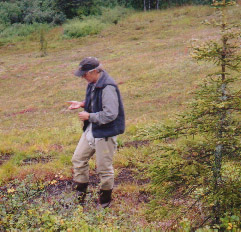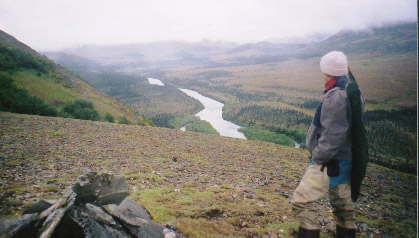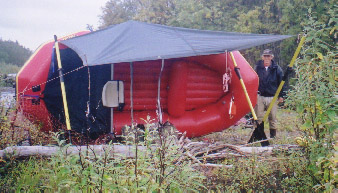Alaska Diary: Day 8, September 7, 2001
 On this day we started a pattern of hiking nearby hills after breakfast and then floating for a few hours into the afternoon. We arose to a misty and gray day (as usual) and were glad to see that the river level had dropped overnight. This meant that we could camp without worrying about rising water during the night. After our usual breakfast, the high point being a perfect cup of coffee for me--the right combination of grounds and brewing time in the press, we decided to pump up the raft, which had gotten kind of floppy. We were dreading this project; we had received very little instruction and it seemed that a lot could go wrong. But it turned out to be very easy. A cap had to be unscrewed on the raft and then the hose was stuck into the hole. A few pumps made that section tight. There were 7 or 8 sections; but the whole operation only took ten minutes.
On this day we started a pattern of hiking nearby hills after breakfast and then floating for a few hours into the afternoon. We arose to a misty and gray day (as usual) and were glad to see that the river level had dropped overnight. This meant that we could camp without worrying about rising water during the night. After our usual breakfast, the high point being a perfect cup of coffee for me--the right combination of grounds and brewing time in the press, we decided to pump up the raft, which had gotten kind of floppy. We were dreading this project; we had received very little instruction and it seemed that a lot could go wrong. But it turned out to be very easy. A cap had to be unscrewed on the raft and then the hose was stuck into the hole. A few pumps made that section tight. There were 7 or 8 sections; but the whole operation only took ten minutes.
 We wandered up and down our gravel bar discussing what to do, looking at the rocks and skipping rocks. Norm suggested that we climb up Little Crow Hills, just on the other side of the river. The top ridge was alive with birds: ravens circled, two golden eagles came and went and several magpies flew from tree to tree. Here's how Norm described the beginning of the hike:
We wandered up and down our gravel bar discussing what to do, looking at the rocks and skipping rocks. Norm suggested that we climb up Little Crow Hills, just on the other side of the river. The top ridge was alive with birds: ravens circled, two golden eagles came and went and several magpies flew from tree to tree. Here's how Norm described the beginning of the hike:
 The problem was there that we had to get across this swift current, high enough up so that when we came back we could row back down to our campsite. Because if we were swept downriver by the current, it would have -- we would have played hell getting back up to our stuff. And all we had was the raft and our guns and a day pack, so that lining operation was pretty important so we could get positioned, be reunited at our campsite with our gear.
The problem was there that we had to get across this swift current, high enough up so that when we came back we could row back down to our campsite. Because if we were swept downriver by the current, it would have -- we would have played hell getting back up to our stuff. And all we had was the raft and our guns and a day pack, so that lining operation was pretty important so we could get positioned, be reunited at our campsite with our gear.
The "lining operation" was our pulling the raft upstream in the slack water near the island as far as we could, rowing across as quickly as possible and having Norm grab the first bush or limb that he could. We tied the raft very securely and then headed off.
 We passed through some very soggy, mossy forest and began to ascend the hill. We passed a small depression on a little flat spot on the slope and I thought it might be a caribou bed. After some more climbing, we came out of the tree line and quickly took some pictures because we saw the fog moving in. We hiked up farther to the summit and saw 7 or 8 caribou on the next ridge. The climbing had warmed us and made us a little thirsty and we started eating the blueberries that grew in the low bushes at our feet. They were delicious. We ate so many that we began to notice subtle differences in the taste from different subspecies and age.
We passed through some very soggy, mossy forest and began to ascend the hill. We passed a small depression on a little flat spot on the slope and I thought it might be a caribou bed. After some more climbing, we came out of the tree line and quickly took some pictures because we saw the fog moving in. We hiked up farther to the summit and saw 7 or 8 caribou on the next ridge. The climbing had warmed us and made us a little thirsty and we started eating the blueberries that grew in the low bushes at our feet. They were delicious. We ate so many that we began to notice subtle differences in the taste from different subspecies and age.
 At the summit we found some interesting structures. Large pieces of rock were arranged like a tepee: 2 or 3 feet high. There was nothing inside. We discussed their age: were they prehistoric or from more recent caribou hunters? We had great views of the river. We looked upriver to near Golden Gate and the Kilbuck Mountains. Downstream we saw the river meander off to the horizon. We began to cool off and headed back down. When we passed the little depression, we noticed a pile of bear droppings and realized that it was a recent bear bed.
At the summit we found some interesting structures. Large pieces of rock were arranged like a tepee: 2 or 3 feet high. There was nothing inside. We discussed their age: were they prehistoric or from more recent caribou hunters? We had great views of the river. We looked upriver to near Golden Gate and the Kilbuck Mountains. Downstream we saw the river meander off to the horizon. We began to cool off and headed back down. When we passed the little depression, we noticed a pile of bear droppings and realized that it was a recent bear bed.
 We were able to recross the river above our camp and in half an hour had packed everything and were on our way. After our hike, it seemed so easy to just float down the river and absorb the scenery with hardly any exertion. At first the riverbanks were high, cut banks or high rocky cliffs. Gradually the river began to braid into many channels. We realized that we were floating down a flood: whole trees and large sections of tundra/sod had washed up in various places. So now instead of dodging rocks we now had to avoid whole trees and pick the channel with the most water.
We were able to recross the river above our camp and in half an hour had packed everything and were on our way. After our hike, it seemed so easy to just float down the river and absorb the scenery with hardly any exertion. At first the riverbanks were high, cut banks or high rocky cliffs. Gradually the river began to braid into many channels. We realized that we were floating down a flood: whole trees and large sections of tundra/sod had washed up in various places. So now instead of dodging rocks we now had to avoid whole trees and pick the channel with the most water.
 We decided to camp near the base of an un-named 1200' mountain. We had learned that hiking through lowlands was not fun. The ground is not solid, the trees are thick and huge clouds of bugs can emerge if it is warm enough. The river narrowed and the braids stopped as we approached. We went to the left bank but our speed had increased so much that Norm could have lost an arm if he had tried to grab something. We tried the right bank. We got out of the current and were able to tie up, but a big pile of bear droppings sent us back to our raft and downstream.
We decided to camp near the base of an un-named 1200' mountain. We had learned that hiking through lowlands was not fun. The ground is not solid, the trees are thick and huge clouds of bugs can emerge if it is warm enough. The river narrowed and the braids stopped as we approached. We went to the left bank but our speed had increased so much that Norm could have lost an arm if he had tried to grab something. We tried the right bank. We got out of the current and were able to tie up, but a big pile of bear droppings sent us back to our raft and downstream.
 We stopped at another gravel bar, which was our last chance to stop near this mountain, but again bear droppings. We continued downstream and found a somewhat muddy gravel bar. It did have a large amount of driftwood and by using wood that was off the ground we had a fire going easily. We made an improvement to our "living area": we leaned the raft toward where we sat and supported it with the oars--simple and quick. We got talking about our guns and check them in their cases; they were wet. Apparently water had condensed in there. We dried them and then shot off a round to make sure our ammo was dry; it was. I made a good supper of some pinto beans and rice that I had cooked at home and rehydrated during the day. A candy bar for desert and more reading of River Horse for entertainment. We watched the fire until about 10:00 and then went to bed with our guns close at hand because, again, our tent was near our cooking area.
We stopped at another gravel bar, which was our last chance to stop near this mountain, but again bear droppings. We continued downstream and found a somewhat muddy gravel bar. It did have a large amount of driftwood and by using wood that was off the ground we had a fire going easily. We made an improvement to our "living area": we leaned the raft toward where we sat and supported it with the oars--simple and quick. We got talking about our guns and check them in their cases; they were wet. Apparently water had condensed in there. We dried them and then shot off a round to make sure our ammo was dry; it was. I made a good supper of some pinto beans and rice that I had cooked at home and rehydrated during the day. A candy bar for desert and more reading of River Horse for entertainment. We watched the fire until about 10:00 and then went to bed with our guns close at hand because, again, our tent was near our cooking area.


